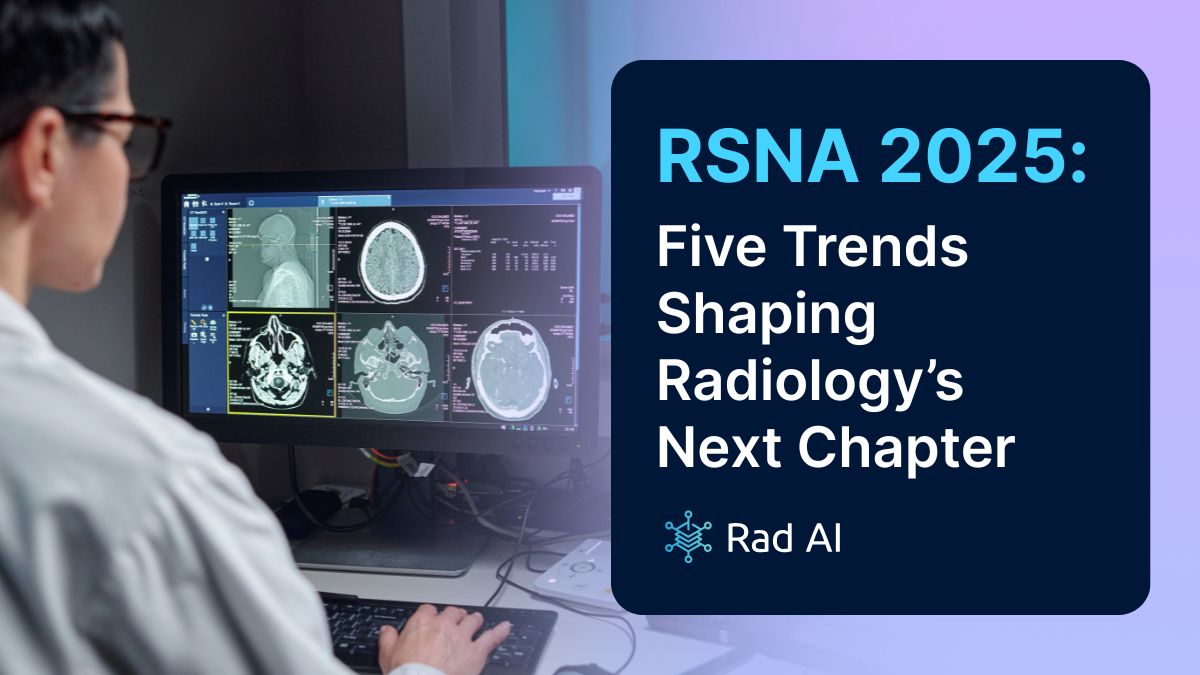RSNA 2025: Five Trends Shaping Radiology’s Next Chapter


As RSNA’s 2025 Annual Meeting approaches, radiology arrives at a defining inflection point—the focus is no longer on what’s coming next, but on what truly scales. The industry has transitioned from experimentation to the era of execution, where success is measured by how effectively ideas are integrated, sustained, and deliver a measurable impact. This year’s theme, Imaging the Individual, embodies that shift, spotlighting precision, connection, and outcomes. Here are five trends that will guide the conversation in Chicago.
In this blog, we explore five trends we expect to shape the discussions and decisions in Chicago.
1) AI Moving from Pilot to Practice
AI in radiology is no longer a research experiment or proof of concept. Health systems are integrating it directly into daily workflows to improve efficiency, accuracy, and clinical impact. The question is shifting from whether AI works to how it integrates, scales, and delivers lasting impact across diverse clinical settings.
As Demetri Giannikopoulos, Chief Innovation Officer at Rad AI, noted in MedCity News, so-called “free” AI pilots often come with hidden costs that outweigh their benefits—reinforcing why the focus at RSNA 2025 is shifting toward enterprise readiness, measurable value, and sustainable implementation.
At RSNA 2025, sessions in the AI Showcase will explore the realities of enterprise adoption, from model lifecycle management and validation to long-term performance tracking. Radiology leaders will focus on tools that enhance workflow efficiency, reduce manual steps, and demonstrate consistent value beyond initial deployment.
2) Precision Imaging and “Imaging the Individual”
This year’s theme highlights the increasing impact of radiology on precision medicine and patient-centered care. RSNA describes Imaging the Individual as a call to advance diagnostic precision, improve outcomes, and promote equitable, high-quality care across populations. Imaging is no longer viewed only as a diagnostic checkpoint; it’s becoming a driver of individualized insight that connects directly to the patient journey.
Sessions at RSNA 2025 will explore imaging biomarkers, radiomics, AI-assisted diagnostics, and new approaches to reducing disparities in access and quality. Together, these highlight how imaging now functions as the fulcrum of care—touching nearly every patient at some stage of diagnosis or treatment and guiding the decisions that shape outcomes.
3) Infrastructure, Standards, and Interoperability as Foundations for Growth
The success of any imaging innovation depends on what supports it behind the scenes. As radiology departments modernize, interoperability has become essential to scalability and collaboration. This year, the focus turns to architectures that enable seamless data exchange, integration of AI tools, and real-time analytics across PACS, RIS, and EHR systems.
The Interoperability Pavilion and Technical Exhibits will showcase how DICOMweb, FHIR, and cloud-native platforms are redefining data connectivity. These standards serve as strategic enablers for institutions seeking to expand capabilities without fragmenting their systems or duplicating efforts. In an increasingly integrated ecosystem, flexibility and openness are now competitive advantages.
4) Real-World Evidence and Measurable Impact
Radiology’s approach to innovation has become more data-driven and outcomes-oriented. As adoption grows, imaging leaders are focusing on how new tools can demonstrate tangible impact in real-world settings—across quality, efficiency, and patient experience. The conversation has matured from early exploration to continuous measurement, ensuring that innovation translates into everyday value for both clinicians and patients.
RSNA 2025 will highlight multi-institution collaborations, longitudinal studies, and data demonstrating how workflow technology and AI are shaping performance at scale. This evolution reflects a broader shift toward transparency and shared learning: health systems are no longer asking if new solutions deliver impact, but rather how that impact can be sustained and expanded over time.
5) Collaboration and Strategic Partnerships Driving Innovation
Radiology’s continued progress increasingly depends on collaboration among medical societies, healthcare organizations, and technology innovators. These partnerships are accelerating how research, workflow solutions, and clinical expertise converge to advance care.
A defining example of this shift is the first-of-its-kind partnership between RSNA Ventures, the newly launched innovation arm of the Radiological Society of North America, and Rad AI. For the first time in its 100-year history, RSNA is signaling a new era of collaboration between medical societies and industry, designed to bring trusted evidence directly into radiologists' workflows. This partnership combines RSNA’s century of peer-reviewed research with Rad AI Reporting, helping radiologists save time, reduce fatigue, and make more confident, evidence-based decisions.
👉 Get a first look at the joint demo during RSNA 2025.
Partnerships like this demonstrate how radiology is uniting credibility and innovation to deliver measurable impact. Rather than focusing solely on individual tools, the industry is creating interconnected ecosystems that strengthen reliability, interoperability, and trust, laying the foundation for sustainable progress in medical imaging.
Beyond RSNA: The Real Work Begins
Radiology’s direction going into 2026 is clear: the field is shifting from isolated innovation to integrated, data-driven practice. Each of this year’s major themes—AI adoption, precision imaging, interoperability, measurable outcomes, and collaboration—points toward a shared goal: building a sustainable ecosystem where technology strengthens both care delivery and the radiologist’s experience.
The most meaningful progress will happen after RSNA, as new insights and collaborations turn into practical improvements across radiology departments. The focus moving forward is to ensure that innovation inspires action and drives measurable, lasting improvements in care delivery.





